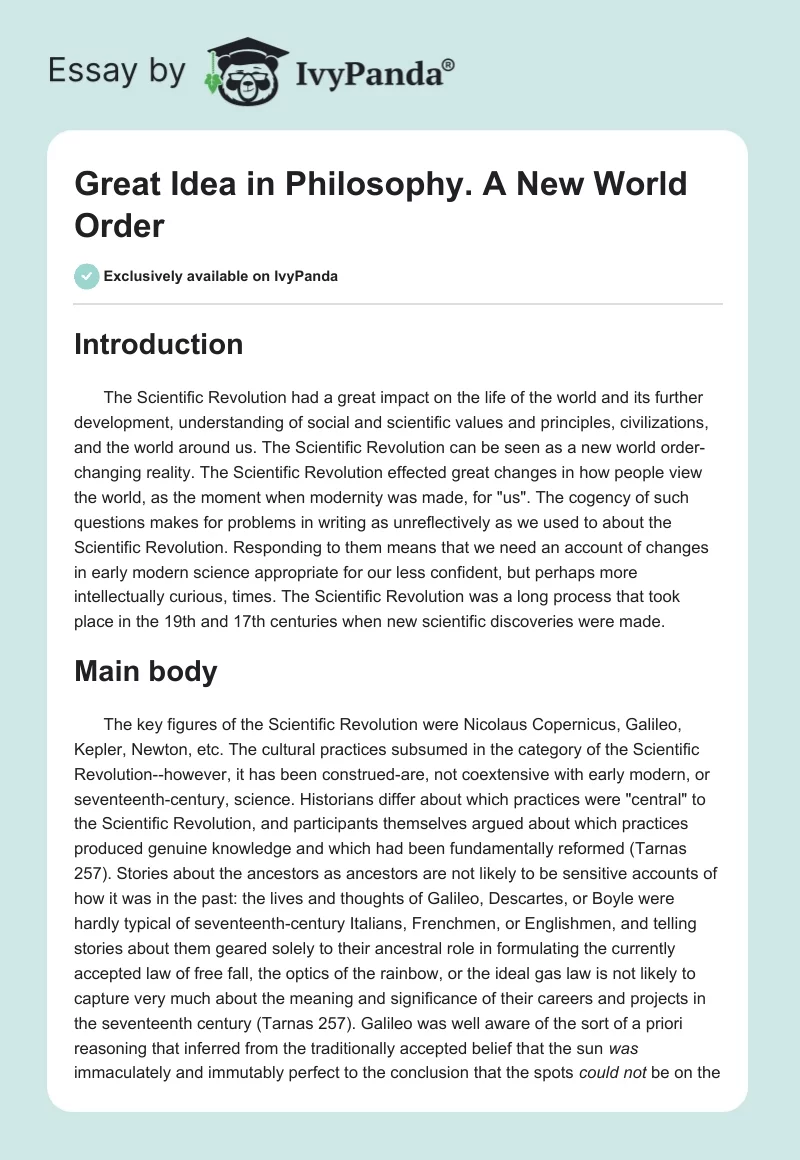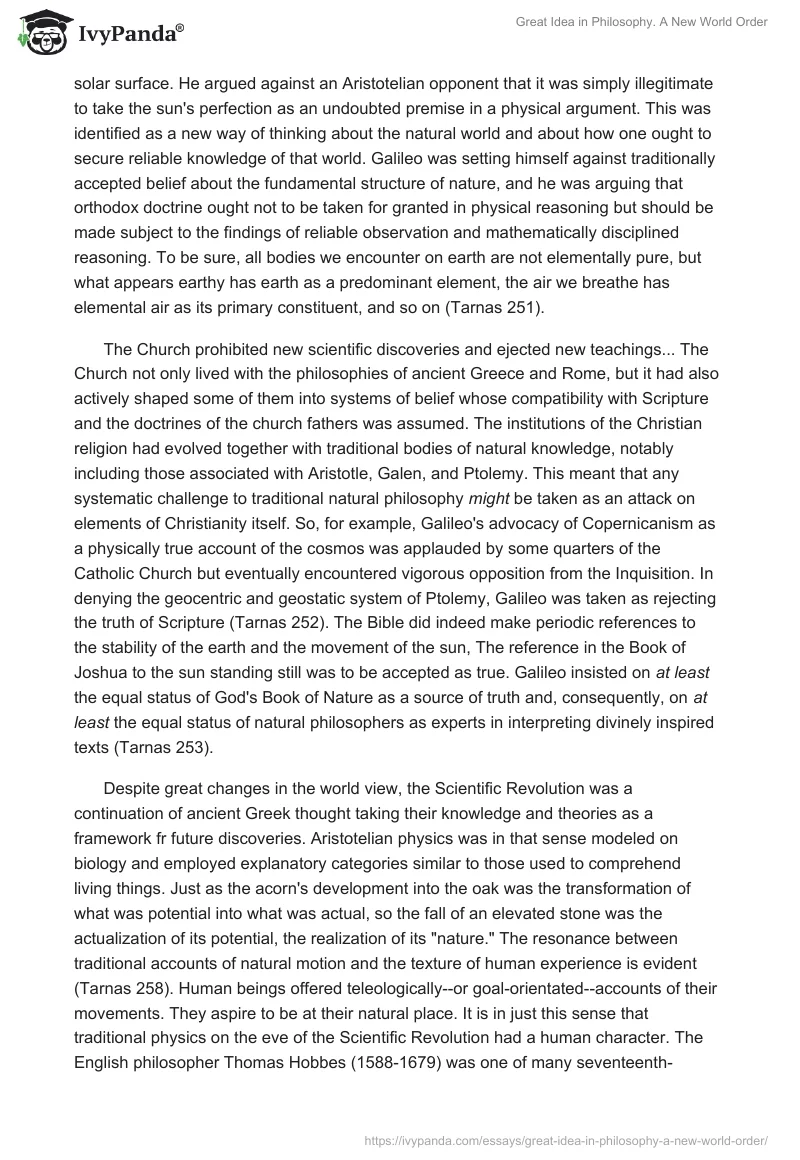Introduction
The Scientific Revolution had a great impact on the life of the world and its further development, understanding of social and scientific values and principles, civilizations, and the world around us. The Scientific Revolution can be seen as a new world order-changing reality. The Scientific Revolution effected great changes in how people view the world, as the moment when modernity was made, for “us”. The cogency of such questions makes for problems in writing as unreflectively as we used to about the Scientific Revolution. Responding to them means that we need an account of changes in early modern science appropriate for our less confident, but perhaps more intellectually curious, times. The Scientific Revolution was a long process that took place in the 19th and 17th centuries when new scientific discoveries were made.
Main body
The key figures of the Scientific Revolution were Nicolaus Copernicus, Galileo, Kepler, Newton, etc. The cultural practices subsumed in the category of the Scientific Revolution–however, it has been construed-are, not coextensive with early modern, or seventeenth-century, science. Historians differ about which practices were “central” to the Scientific Revolution, and participants themselves argued about which practices produced genuine knowledge and which had been fundamentally reformed (Tarnas 257). Stories about the ancestors as ancestors are not likely to be sensitive accounts of how it was in the past: the lives and thoughts of Galileo, Descartes, or Boyle were hardly typical of seventeenth-century Italians, Frenchmen, or Englishmen, and telling stories about them geared solely to their ancestral role in formulating the currently accepted law of free fall, the optics of the rainbow, or the ideal gas law is not likely to capture very much about the meaning and significance of their careers and projects in the seventeenth century (Tarnas 257). Galileo was well aware of the sort of a priori reasoning that inferred from the traditionally accepted belief that the sun was immaculately and immutably perfect to the conclusion that the spots could not be on the solar surface. He argued against an Aristotelian opponent that it was simply illegitimate to take the sun’s perfection as an undoubted premise in a physical argument. This was identified as a new way of thinking about the natural world and about how one ought to secure reliable knowledge of that world. Galileo was setting himself against traditionally accepted belief about the fundamental structure of nature, and he was arguing that orthodox doctrine ought not to be taken for granted in physical reasoning but should be made subject to the findings of reliable observation and mathematically disciplined reasoning. To be sure, all bodies we encounter on earth are not elementally pure, but what appears earthy has earth as a predominant element, the air we breathe has elemental air as its primary constituent, and so on (Tarnas 251).
The Church prohibited new scientific discoveries and ejected new teachings… The Church not only lived with the philosophies of ancient Greece and Rome, but it had also actively shaped some of them into systems of belief whose compatibility with Scripture and the doctrines of the church fathers was assumed. The institutions of the Christian religion had evolved together with traditional bodies of natural knowledge, notably including those associated with Aristotle, Galen, and Ptolemy. This meant that any systematic challenge to traditional natural philosophy might be taken as an attack on elements of Christianity itself. So, for example, Galileo’s advocacy of Copernicanism as a physically true account of the cosmos was applauded by some quarters of the Catholic Church but eventually encountered vigorous opposition from the Inquisition. In denying the geocentric and geostatic system of Ptolemy, Galileo was taken as rejecting the truth of Scripture (Tarnas 252). The Bible did indeed make periodic references to the stability of the earth and the movement of the sun, The reference in the Book of Joshua to the sun standing still was to be accepted as true. Galileo insisted on at least the equal status of God’s Book of Nature as a source of truth and, consequently, on at least the equal status of natural philosophers as experts in interpreting divinely inspired texts (Tarnas 253).
Despite great changes in the world view, the Scientific Revolution was a continuation of ancient Greek thought taking their knowledge and theories as a framework fr future discoveries. Aristotelian physics was in that sense modeled on biology and employed explanatory categories similar to those used to comprehend living things. Just as the acorn’s development into the oak was the transformation of what was potential into what was actual, so the fall of an elevated stone was the actualization of its potential, the realization of its “nature.” The resonance between traditional accounts of natural motion and the texture of human experience is evident (Tarnas 258). Human beings offered teleologically–or goal-orientated–accounts of their movements. They aspire to be at their natural place. It is in just this sense that traditional physics on the eve of the Scientific Revolution had a human character. The English philosopher Thomas Hobbes (1588-1679) was one of many seventeenth-century critics of Aristotelianism who discredited traditional physical beliefs by drawing sarcastic attention to their anthropomorphism. The framework that modern natural philosophers preferred to Aristotelian teleology was one that explicitly modeled nature on the characteristics of a machine. So central was the machine to important strands of new science that many exponents liked to refer to their practice as the mechanical philosophy (Tarnas 300). In light of the Scientific Revolution, the “fate” of the Church was a loss of control over the social, political, and economic life of the society (Tarnas 301). The new philosophy assaulted common sense at a mundane as well as a cosmic level. Consider the general treatment of motion in “modern” physics. The Scientific Revolution ruined the main dogmas and principles of the Church. To do this would be an expression of just the same sort of legitimate historical interest displayed by Darwinian evolutionists telling stories about those branches of the tree of life that led to human beings–without assuming in any way that such stories are adequate accounts of what life was like hundreds of thousands of years ago (Tarnas 305). Bacon agreed with Galileo that Scripture was a book demanding expert interpretation if its true meaning was to be discerned. But if the parallel Book of Nature could be read aright-with the discipline of proper method–then the natural philosopher could contribute as much as the theologian (Tarnas 272).
Conclusion
In sum, the Scientific Revolution changed the social, economic, and political life of the civilization bringing new knowledge and understanding of reality. Modern practitioners disputed the nature and the limits of mechanical explanation, but proper mechanical accounts of nature were widely recognized as the goal and the prize. Yet the very idea of construing nature as a machine, and using understandings derived from machines to interpret the physical structure of nature, counted as a violation of one of the most basic distinctions of Aristotelian philosophy. This strategy sought to open up a legitimate space for the expertise of the natural philosopher, independent of theological expertise, but not in any necessary conflict with it
Works Cited
Tarnas, R. Passion of the Western Mind. Ballantine Books, 1993


